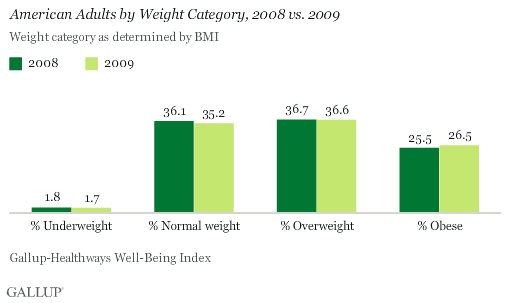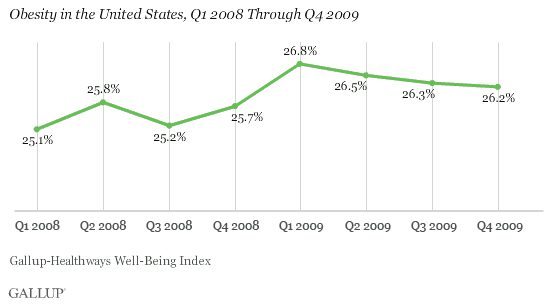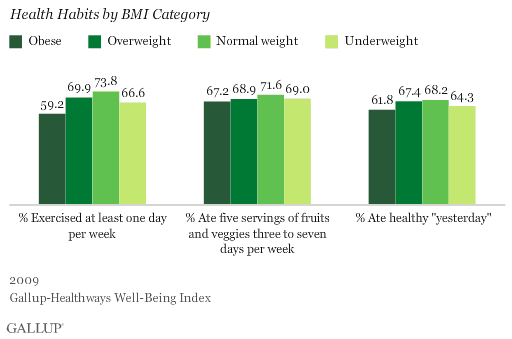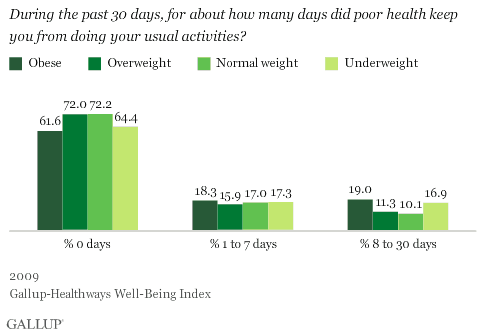WASHINGTON, D.C. -- More than 6 in 10 American adults (63.1%) were either overweight (36.6%) or obese (26.5%) in 2009, up a small but measurable amount from the 62.2% who were classified as overweight or obese in 2008. The shift is primarily because of fewer people reporting a normal weight BMI and more being classified as obese.

ÆéûÜǨû§and Healthways survey approximately 1,000 Americans each day, with more than 350,000 surveys completed in 2008 and in 2009. Obesity is assessed on the basis of respondents' self-reports of their height and weight, which are then used to calculate BMI scores. Individual BMI values of 30 or above are classified as "obese," 25 to 29.9 are "overweight," 18.5 to 24.9 are "normal weight," and 18.4 or less are "underweight."
Tracking obesity by quarter shows that despite minor fluctuations, the obesity rate in the United States remained elevated throughout 2009 in comparison to 2008. Across the eight quarters of measurement, obesity peaked in the first quarter of last year and then declined in each of the following quarters of 2009, though not to a statistically significant degree.

Obese Less Likely to Exercise and Eat Healthy
Along with collecting height and weight data of Americans, ÆéûÜǨû§and Healthways measure healthy behaviors in the United States, including respondents' self-reported exercise and eating habits. In terms of physical activity, the Gallup-Healthways Well-Being Index specifically asks Americans on how many days in the last seven days they exercised for at least 30 minutes. Obese Americans (59.2%) are significantly less likely than those who are overweight (69.9%) or of a normal weight (73.8%) to report exercising at least one day per week.
The Gallup-Healthways Well-Being Index includes a similar question about fruit and vegetable consumption. The obese are slightly less likely than those in every other BMI category to say they ate five servings of fruits and vegetables on at least three of the past seven days. Obese Americans are also less likely to say they ate healthy "all day yesterday." The differences on healthy eating between obese and other Americans, however, are relatively small and not as great as the differences between these groups on exercise.

Chronic Conditions Rampant Among Obese
The relationship between a high BMI and various health problems has been well-documented in traditional scientific literature, and Gallup-Healthways Well-Being Index surveys from 2009 confirm these findings. Those who are obese are far more likely than those who are a normal weight and those who are overweight to report being diagnosed with high blood pressure, high cholesterol, diabetes, and to have had a heart attack. ÆéûÜǨû§has also previously reported a during the past two years in the U.S., concomitant with an increase in obesity, as well as a .

The rate of depression is also higher among those who are obese, with 23.3% reporting they have been diagnosed with depression, compared with 15.0% of those who are normal weight.
Poor Health Hinders Obese From Engaging in Everyday Activities
Likely reflecting the effects of higher rates of chronic conditions, obese Americans are more likely than those who are normal weight or overweight to report that poor health keeps them from doing their usual activities. The obese are almost twice as likely as those who are normal weight to miss out on eight days or more of activities per month because of poor health.

Demographics of the Obese
In 2009, black Americans were among the most likely to be obese, at a rate (36.2%), which is nearly 10 percentage points higher than the national average of 26.5%. The obesity rate among Hispanics is also higher than the nation's average, at 28.3%. Asians are significantly less likely to be obese than the general population, with 9.6% falling into the obese category.
Examining obesity by age group reveals a distinct pattern. The rate among young Americans is 18.3%; it then increases among middle-aged groups, to 27.6% among 30- to 44-year-olds and 30.6% among 45- to 64-year-olds, before dropping off among seniors. Additionally, men are more likely than woman to be obese.

Bottom Line
Year-over-year comparisons find the percentage of Americans who are obese is on the rise, with more than a quarter of the adult population falling into this unhealthy weight group according to Gallup-Healthways Well-Being Index data. With behavioral data revealing poor exercise and eating habits among most of those who are classified as obese, helping to reverse the current trend in obesity could require active involvement of communities, businesses, and the government in addition to motivating individuals themselves to improve their health habits. Each of these constituencies does stand to gain from decreasing obesity levels in the U.S., as obese Americans are more likely to report being unable to engage in normal activities because of poor health, the lost productivity and economic implications of which, at the personal and societal level, may be negative for the country as a whole. Further, communities, businesses, and the government may want to focus on the four groups with obesity rates higher than the national average: blacks, Hispanics, men, and middle-aged Americans.
Learn more about the .
Survey Methods
Results are based on telephone interviews with 673,020 national adults, aged 18 and older, conducted Jan. 2, 2008-Dec. 31, 2009, as part of the Gallup-Healthways Well-Being Index.
Approximately 88,000-90,000 surveys are completed each quarter. For quarterly results based on the total sample of national adults, one can say with 95% confidence that the maximum margin of sampling error is ôÝ0.3 percentage points.
Interviews are conducted with respondents on landline telephones (for respondents with a landline telephone) and cellular phones (for respondents who are cell phone only and cell phone mostly).
In addition to sampling error, question wording and practical difficulties in conducting surveys can introduce error or bias into the findings of public opinion polls.
About the Gallup-Healthways Well-Being Index
The Gallup-Healthways Well-Being Index measures the daily pulse of U.S. wellbeing and provides best-in-class solutions for a healthier world. To learn more, please visit .
